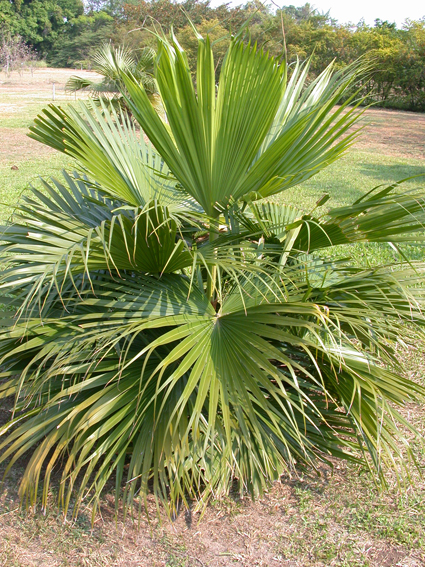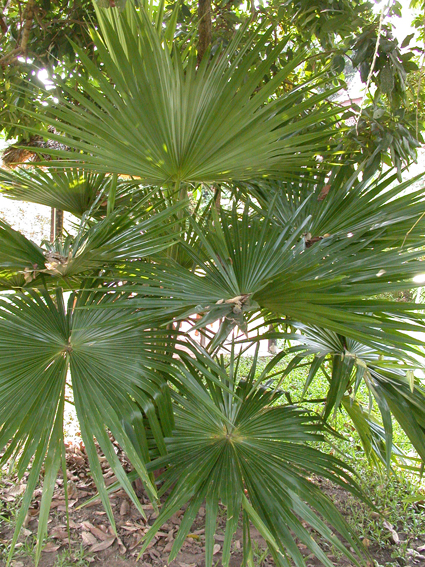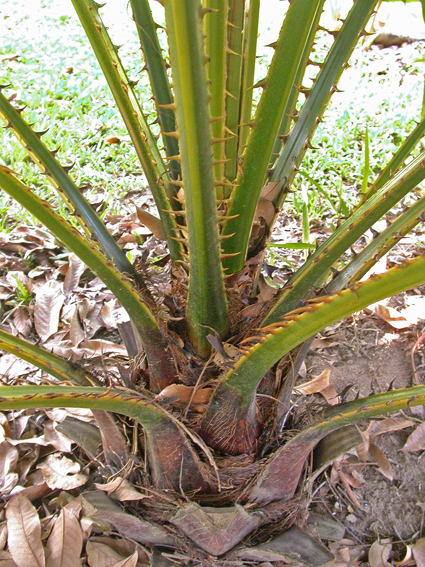Livistona palms
There is a genus of fan-palms often seen in Thai gardens; Livistona. There are only about 33 species from NE Africa, tropical Asia and Australia so it is fairly easy to get a grip of them. Although only 4-5 species are considered native to Thailand, their beauty make exotic species popular too, so an identification of a palm tree in a garden must not rely on a local forest flora.
All members of Livistona have palmate fan-like leaves, often with a short mid-rib (costa), leaf stalks with more or less prominent spines, solitary stems, usually bisexual flowers, globose or elongated 1-seeded fruits without groves.
 A young Livistona chinensis. Note the green underside of the top leaf.
A young Livistona chinensis. Note the green underside of the top leaf.
There is one group of Livistona palms with drooping leaf-tips, quite ornamental. Common species in Thai gardens are Livistona chinensis (Native to the coastal forests of Taiwan and Hainan, fruits blue-green, leaves divided only halfway), L. drudei (Australian, fruits black) and L. saribus (Southeast Asian species, edible blue fruits, deeply divided leaves almost to base into groups of segments).
A young Livistona jenkinsiana syn. L. speciosa. Note the greyish underside of the top leaf.
Another group of Livistona palms have stiff leaf tips which do not droop. Common species in Thai gardens are Livistona australis (Australia, leaf stalks almost unarmed), Livistona jenkinsiana (India and Southeast Asia, heavily armed leaf stalks, leaves greyish green below, fruit wider than long, possibly conspecific with L. speciosa), L. muelleri (Australian, slow-growing and not taller than 6m), L. rotundifolia (from rainforests in Malaysia and Indonesia and so unsuitable here in the dry Chiang Mai) and the native wild L. speciosa (fruit longer than wide, possibly conspecific with L. jenkinsiana which is the oldest and therefore valid name).
The leaf stalks (petioles) of L. jenkinsiana are armed with impressive spines resembling rose-thorns or scolopender feet.
The genus name Livistona was coined by Robert Brown in 1810; “Dixi in memoriam viri nobilis Patricii Murray Baronis de Livistone”. Patrick Murray (1634-1670) created a private botanical garden at his estate, which after his death was merged with that of his teacher’s Sir Andrew Balfour. The combined collections became the foundation of today’s Royal Botanic Garden Edinburgh.
Palms can be divided into fan palms with palmate leaves including the genus Livistona (subfamily Coryphoideae), climbing palms or rattans (Calamoideae), nipa palm which grows in mangroves and has erect leaves (Nypoideae) and pinnate palms (subfamilies Arecoideae with flowers in groups of three, one female and two male, e.g. coconut, Ceroxyloideae with spirally arranged flowers, largely South American, e.g. frost hardy Ceroxylon and Phytelephantoideae which are always bisexual (monoecious)).
Text & Photo: Eric Danell





Why no mention of L. speciosa which is emergent on some of the northern mountain tops and abundant on the road to Umphang in Tak?
I planted one from a forest nursery on a mountain in Nanoi, Nan where old palms grow nearby in the forest, which is now over 2 metres high. The leaves are not pendulous ( unlike the L chinensis in this link http://www.palmantics.com/palms/description_livistona_chinensis/ ) and I have not noticed a distinctly greyish colour on the underside.
I wonder if it is too early to identify the young specimen in your pic as the leaves do not appear so pendulous to me?
Hi Ricky!
Livistona speciosa and L. jenkinsiana are considered synonymous by some authors so the picture labeled L. jenkinsiana could also be labeled L. speciosa. A 2 m specimen should absolutely show the characteristics of either species. To be certain of different shades of green, cut two leaves, put them side by side in the shade, and turn one upside down.
Looks like I need to go collecting in Nan.
That info is wrong, it’s Saribus speciosus that’s the syn., of Livistona jenkinsiana! edric
Artabotrys siamensis trails upwards with great ease, while A. hexapetalus remains a shrub with poor trailing abilities.